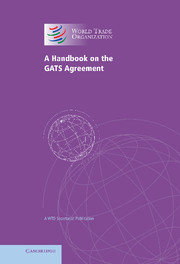Book contents
- Frontmatter
- Contents
- Preface
- Introduction
- 1 Basic purpose and concepts
- 2 Main building blocks: agreement, annexes and schedules
- 3 A closer look at domestic regulation
- 4 How the GATS is administered
- 5 The role and responsibilities of Member governments
- 6 The challenges ahead
- 7 Preparing requests and offers
- 8 Misconceptions about the GATS
- Appendix 1 Understanding your country's services trade
- Appendix 2 Relevant services statistics and classifications
- Annex: General Agreement on Trade in Services
- Index
Introduction
Published online by Cambridge University Press: 07 October 2011
- Frontmatter
- Contents
- Preface
- Introduction
- 1 Basic purpose and concepts
- 2 Main building blocks: agreement, annexes and schedules
- 3 A closer look at domestic regulation
- 4 How the GATS is administered
- 5 The role and responsibilities of Member governments
- 6 The challenges ahead
- 7 Preparing requests and offers
- 8 Misconceptions about the GATS
- Appendix 1 Understanding your country's services trade
- Appendix 2 Relevant services statistics and classifications
- Annex: General Agreement on Trade in Services
- Index
Summary
The General Agreement on Trade in Services (GATS) is a relatively new agreement. It entered into force in January 1995 as a result of the Uruguay Round negotiations to provide for the extension of the multilateral trading system to services. With a view to achieving a progressively higher level of liberalization, pursuant to Article XIX of the GATS, WTO Members are committed to entering into further rounds of services negotiations. The first such round started in January 2000.
All Members of the WTO are signatories to the GATS and have to assume the resulting obligations. So, regardless of their countries' policy stances, trade officials need to be familiar with this agreement and its implications for trade and development. These implications may be far more significant than available trade data suggest.
Hopefully, these materials will contribute to a better understanding of the GATS and the challenges and opportunities of the ongoing negotiations. For users who are familiar with the General Agreement on Tariffs and Trade (GATT), similarities and differences will be pointed out where relevant. Likewise, for users who are familiar with the balance-of-payments definition of “trade”, departures from the Agreement's coverage will be explained. Whenever indicated, it is recommended to supplement these materials with documents available on the WTO website (www.wto.org).
To stimulate further thinking about core concepts and implications of the Agreement, several boxes have been inserted to provide “Food for thought”.
- Type
- Chapter
- Information
- A Handbook on the GATS AgreementA WTO Secretariat Publication, pp. 1Publisher: Cambridge University PressPrint publication year: 2005

